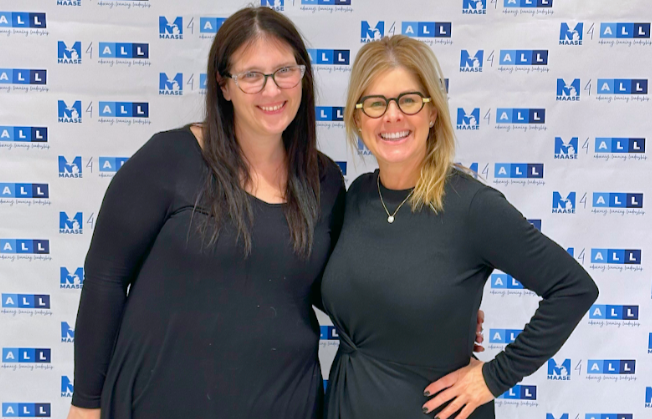Social Narratives: Helping Autistic Children Understand Social Situations
This resource was created as a supplement for the ARIS® Academic Readiness Intervention System Language Builder complete early autism curriculum. Learn more about the ARIS curriculum.
Social narratives (often referred to as Social StoriesTM) are carefully designed short stories that help autistic children understand new social situations. These social situations can include any interaction involving other people such as riding a school bus, visiting the dentist, or ordering food at a restaurant. Research indicates that these stories help autistic children develop an accurate understanding of new social situations (Gray, 1995).
Autistic children often have difficulty reading other people’s facial expressions and feeling empathy for others and this results in significant deficits in social skills. Research confirms that autistic children have difficulty with social interactions and that these difficulties fall into three types:
- Social recognition related to a lack of interest in others
- Social communication including difficulty expressing one’s self and understanding body language
- Social imitation and understanding, including difficulty understanding the thoughts and feelings of others (Wing, 1988).
 Social narratives are an effective strategy for identifying challenging situations for an autistic child and preparing the child to manage and understand the situation including the who, what, when, where, and why of a social situation (Lorimer, Simpson, Myles, & Ganz, 2002). Gray and Garand first wrote formally about Social StoriesTM in 1993, and they define Social StoriesTM as “a social learning tool that supports the safe and meaningful exchange of information between parents, professionals, and autistic people of all ages (www.carolgraysocialstories.com).
Social narratives are an effective strategy for identifying challenging situations for an autistic child and preparing the child to manage and understand the situation including the who, what, when, where, and why of a social situation (Lorimer, Simpson, Myles, & Ganz, 2002). Gray and Garand first wrote formally about Social StoriesTM in 1993, and they define Social StoriesTM as “a social learning tool that supports the safe and meaningful exchange of information between parents, professionals, and autistic people of all ages (www.carolgraysocialstories.com).
For parents, teachers, and practitioners, it is important when telling a social story to keep in mind that roughly 50% of a social story involves applauding achievement and that the social story being told should be customized to fit the needs and abilities of the child. Gray (2003) emphasizes that Social Stories need to be customized for each child and should have four types of sentences: descriptive, directive, perspective, and affirmative. It is also important to include visual elements in a social narrative (Social StoriesTM) that is shared with an autistic child. Autistic children have challenges in processing auditory information but can be strong visual learners.
A substantial body of research has been conducted related to the effectiveness of social narratives over the past few decades and the criteria for developing effective social stories, while still focused on the original ten components, has been updated regularly to reflect recent research and best practices. The current complete criteria for creating Social StoriesTM are listed below:
Social Stories 10.4 (2023) Criteria
FOUNDATION
Criterion 1: One Social Story Philosophy, Definition, & Goal
One Philosophy, one Definition, and one Goal guide the research, development, and implementation of every Social Story.
- Philosophy: Social Humility (the Social Story philosophy) casts assumptions and social arrogance aside to objectively research, develop, and share each Story or social solution.
- Definition: Recognizing that every human experience and perspective is unique and valid and that social impairments and their solutions are shared, a Social Story accurately describes a personally relevant topic (often a context, skill, achievement, or concept) according to ten defining criteria.
- Goal: Following Social Humility and all of the elements of the Social Story Definition, the Goal of a Social Story is to ensure that the intended message remains intact from Author to Audience.
RESEARCH
Criterion 2: Discovery: Story or Alternate Solution?
Authors gather information to first 1) improve their understanding of the Audience concerning the context of a situation, concept, skill, etc., and then 2) identify the topic and focus of each Story, or discover an alternate solution or intervention.
DEVELOP

Criterion 3: Structure: Organize & Describe
A Social Story has one title that meaningfully represents the topic, a maximum of two descriptive sentences, and one coaching sentence free of assumption or bias, judgment, devaluation, or
unidentified opinion, and three parts: An introduction that describes the topic, a body that adds detail, and a conclusion that reinforces and summarizes the information.
Criterion 4: Format: Tailor & Personalize
Authors tailor each Social Story format to the abilities, attention span, learning style, and, whenever possible, talents and interests of the Audience.
Criterion 5: Tone: Safety & Respect
Every Social Story has a socially humble, safe, patient, positive, unassuming, supportive, and accurate “voice” and vocabulary that is defined by five factors:
- maintains a socially humble tone and format
- contains only first- and/or third-person perspective sentences
- has a consistently patient and positive tone
- describes the connection between related past, present, and future events
- is accurate and meaningful for the audience
Criterion 6: Questions: Consider & Answer
A Social Story™ answers relevant 'WH' questions that describe context, including place (WHERE), time-related information (WHEN), relevant people (WHO), important cues (WHAT), basic activities, behaviors, or statements (HOW), and the reasons or rationale behind them (WHY).
Criterion 7: Celebrate: Praise & Affirm
A minimum of 50% of all Social Stories developed for an Audience praise what the Audience is doing well. Social Stories make celebration a habit!
Criterion 8: Formula: Describe & Maybe Coach
In every Social Story, Descriptive Sentences appear at least four times as often as Coaching Sentences, with a maximum of one Sentence that Coaches the Audience. The title is always a Descriptive Sentence and is counted in the formula.
Criterion 9: Revise: Check & Correct
Every Social Story is checked and corrected until it meets the ten Social Story Criteria.
IMPLEMENT
Criterion 10. Share: Introduce & Monitor
The 10th Criterion structures how each Story is shared with the Audience, ensuring that it is introduced and monitored with the same care that researched and developed it.
Ten considerations guide Author efforts:
1. Plan for comprehension2. Plan Story support
3. Plan Story review
4. Plan a positive introduction
5. Monitor
6. Organize the stories
7. Mix & match to build concepts
8. Story re-runs and sequels to tie past, present, and future
9. Recycle instruction into applause
10. Stay current on Social Story research and updates
Research indicates that Social Stories can be an effective intervention in many types of social situations including:
- Reducing aggressive behavior (e.g. Adams et al., 2004; Cullain, 2000; Kuoch & Mirenda, 2003 as cited in Ozdemir, 2010)
- Teaching adaptive skills (Barry & Burlew, 2004; Brownell, 2002 as cited in Ozdemir, 2010)
- Teaching social skills (Feinberg, 2001; Ozdemir, 2008a; Tierman & Goldstein, 2004 as cited in Ozdemir, 2010),
- Increasing appropriate behaviors (Agosta, Graetz, Mastropieri, & Scruggs, 2004; Cullain, 2000; Graetz, 2003; Kuoch & Mirenda, 2003, Smith, 2001 as cited in Ozdemir, 2010),
- Increasing the use of appropriate social skills (Barry & Burley 2004; Hagiwara & Myles, 1999; Pettigrew, 1998 as cited in Ozdemir, 2010),
- Increasing greeting behavior and initiation of play activities (Feinberg, 2001 as cited in Ozdemir, 2010)
- Increasing on-task behavior (Brownell, 2002 as cited in Ozdemir, 2010)
- Increasing appropriate meal-eating behavior (Staley, 2001 as cited in Ozdemir, 2010)
- Decreasing precursors of tantrum behaviors (Simpson & Myles, 2002 as cited in Ozdemir, 2010).
Social narratives are a proven strategy that works especially well with autistic children. Typically developing children intuitively figure out how to read a room or behave appropriately in new and familiar situations, but autistic children often find social situations confusing and difficult to navigate.
Heather Dorn, MS BCBA, has created a series of Social Narratives for STAGES® Learning.
- Going to the Dentist
 Following Game Rules
Following Game Rules- Going to the Doctor
- Getting Hurt
- Going to an Assembly
- Getting Sick
- Doing School Work at Home
- Getting and Giving Valentines
- Learning from Losing
Note: The social narratives provided above are technically not "social stories," but can be used as common social scenarios that can be adapted for a specific child. To confirm that your adaptation fits all the criteria for a social story see:
https://carolgraysocialstories.com/wp-content/uploads/2015/09/It-is-NOT-a-Social-Story-if....pdf
References:
This article was adapted from information on Carol Gray’s website: https://carolgraysocialstories.com/
The updated 10 Criteria listed above are from Social Stories 10.4 Criteria by
Carol Gray, Catherine Faherty, Dr. Siobhan Timmins, & Aaron Lanou, MSEd
Other research articles consulted and cited in this article include:
Gray, C. (1995). Teaching children diagnosed with autism to “read” social situations. In K. Quill (Ed.), Teaching children with autism: Strategies to enhance communication and socialization, pp.219-241. Albany, NY: Delmar.
Gray, C. and J. Garand (1993). Social Stories: Improving responses of students with autism with accurate social information. Focus on Autistic Behavior, 8, pp. 1-10
Kuoch, P. Mirenda (2003). Social Story interventions for young children with autism spectrum disorders. Focus on Autism and Other Developmental Disabilities, 18, pp. 219-227.
Adams, A. Gouvousis, M. Van Lue, C. Waldron (2004). Social story intervention: Improving communication skills in a child with autism spectrum disorder. Focus on Autism and Other Developmental Disabilities, 19 (2), pp. 84-87.
Khantreejitranon, Angkhana (2018). Using a social story intervention to decrease inappropriate behavior of preschool children with autism. Kasetsart Journal of Social Sciences, Volume 39, Issue 1, pp. 90-97
L.M. Barry, S.B. Burley (2004) Using social stories to teach choice and play skills to children with autism. Focus on Autism and Other Developmental Disabilities, 19, pp. 45-51
Ozdemir, Selda (2010). Social stories: an intervention technique for children with Autism. Procedia - Social and Behavioral Sciences 5, pp. 1827-1830.
P.A. Lorimer, R.L. Simpson, B.S. Myles, J.B.Ganz (2002). The use of social stories as a preventative behavioral intervention in a home setting with a child with autism. Journal of Positive Behavior Interventions, 4 (1), pp. 53-60
Wing, L. (1988). The continuum of autistic characteristics. In E. Schopler & G. B. Mesibow (Eds.), Diagnosis and assessment in autism, pp.91-110. New York Plenum Press.
This resource was created as a supplement for the ARIS Language Builder: complete early autism curriculum, Lesson #68, Social Stories, and Lesson #152, Tell Me a Story. Download a free copy of lesson 119 and lesson 152, and learn more about the ARIS curriculum.

L.F. Stebbins, M.Ed. M.L.I.S.
L.F. Stebbins has more than twenty-five years of experience in higher education with a background in library and information science, instructional design, research, and teaching. She has an M.Ed. from the Technology Innovation & Education Program at the Harvard Graduate School of Education and a Masters in Information Science from Simmons College. For twenty years she created and led media literacy and research skills programs for students and faculty at Brandeis University. Currently she is the Director at research4Ed.com and the Director for Research at Consulting Services for Education (CS4Ed). For more about Leslie visit LeslieStebbins.com.




